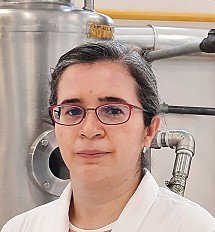
Dra. ALMA HORTENSIA MARTÍNEZ PRECIADO
Resumen curricular:
Profesor Docente Titular A, del Ingeniería Química; Investigador del Laboratorio de Ingeniería y Biotecnología de los Alimentos del Centro Universitario de Ciencias Exactas e Ingenierías, Universidad de Guadalajara. Licenciatura en Ingeniería Química (27.07.2001), Centro Universitario de Ciencias Exactas e Ingenierías, Universidad de Guadalajara. Maestría en Ciencias en Procesos Biotecnológicos (27.11.2004) y Doctorado en Ciencias en Ingeniería Química (20.08.2012), ambos en el Centro Universitario de Ciencias Exactas e Ingenierías, Universidad de Guadalajara. Miembro del Sistema Nacional de Investigadores Nivel I. Perfil Deseable en Programa para el Desarrollo Profesional Docente. Docente a nivel Licenciatura y Posgrado. Direcciones en: Licenciatura (19), Maestría (1), Doctorado (3). 33 artículos publicados en revistas indizadas al Journal Citation Reports (JCR), y 150 citas. 6 capítulos de libros. Coordinadora del Doctorado en Ciencias en Procesos Biotecnológicos (2020 a la fecha). LÍNEA DE INVESTIGACIÓN: Estudio de componentes bioactivos en alimentos y aplicación de técnicas de conservación. CUERPO ACADÉMICO. UDG-CA-166. Ciencias de los Alimentos.
Perfil de Investigador SNII:
Perfil PRODEP:
Bases de datos bibliográficas:
Publicaciones del académico:
- Pithellobium dulce (Roxb.) Benth. Fruit Flour Intake Enhances Short-Chain Fatty Production and Glucose Metabolism in BALB/c Mice
- Industrial Applications, Principal Sources, and Extraction of Galactomannans: A Review
- Pithellobium dulce (Roxb.) Benth. Fruit Flour Intake Enhances Short-Chain Fatty Acid Production and Glucose Metabolism in BALB/c Mice
- Design and Optimization of a Second-Generation Extruded Snack Using Carrot Waste, Blue Corn Flour, and Ellagic Acid as Functional Ingredients
- β-Caryophyllene as a Novel Modulator of the Renin–Angiotensin System: A Path to Reduce Inflammation and Restore Taste Function
- β-Caryophyllene as a Novel Modulator of the Renin–Angiotensin System: A Path to Reduce Inflammation and Restore Taste Function
- Antimicrobial Potential of Nanomaterials Synthesized with Extracts from Annona Plants: A Review
- Immunostimulant effects of diet supplementation with yellow (Pouteria campechiana), white (Casimiroa edulis), and black (Diospyros digyna) sapote nanocapsules on laying hens: in vitro and in vivo study
- Development, characterization, and immunomodulation performance of spray-dried Moringa oleifera seed extract in Longfin yellowtail Seriola rivoliana
- High-performance photodetection of UV-visible-NIR by Ag–Mn2O3 heterojunctions
- High-performance photodetection of UV-visible-NIR by Ag–Mn2O3 heterojunctions
- High-performance photodetection of UV-visible-NIR by Ag–Mn2O3 heterojunctions
- High-performance photodetection of UV-visible-NIR by Ag–Mn2O3 heterojunctions
- High-performance photodetection of UV-visible-NIR by Ag–Mn2O3 heterojunctions
- High-performance photodetection of UV-visible-NIR by Ag–Mn2O3 heterojunctions
- HPLC-DAD Development and Validation Method for Short-Chain Fatty Acids Quantification from Chicken Feces by Solid-Phase Extraction
- Adsorption and photocatalytic degradation of Congo red and malachite green by nanostructured Y2O3 synthesized by the coprecipitation method
- High-performance photodetection of UV-visible-NIR by Ag–Mn2O3 heterojunctions
- High-performance photodetection of UV-visible-NIR by Ag–Mn2O3 heterojunctions
- Consumption of Peach Palm (Bactris gasipaes) Nanocellulose: Glucose Metabolism and Orexigenic/Anorexigenic Hormones in Mice
- Improving Foodborne Pathogen Control Using Green Nanosized Emulsions of Plectranthus hadiensis Phytochemicals
- Immunostimulant effects of diet supplementation with yellow (Pouteria campechiana), white (Casimiroa edulis), and black (Diospyros digyna) sapote nanocapsules on laying hens …
- Corrigendum to “Adsorption and photocatalytic degradation of Congo red and malachite green by nanostructured Y2O3 synthesized by the coprecipitation method”[Open Ceram. 13 …
- An ultraviolet to near-infrared photosensor based on microstructured CuO
- Photocatalytic performance of β-Ga2O3 microcubes towards efficient degradation of malachite green
- Photocatalytic performance of β-Ga2O3 microcubes towards efficient degradation of malachite green
- Photocatalytic performance of β-Ga2O3 microcubes towards efficient degradation of malachite green
- New photosensing properties of nanostructured GdCoO3 in the ultraviolet (A)-visible-near infrared range
- Photocatalytic performance of β-Ga2O3 microcubes towards efficient degradation of malachite green
- Microencapsulation by spray-dryingcontenido of manilkara zapota pulp and probiotics (Lactobacillus fermentum a15): Assessment of shelf-life in a food matrix
- Microencapsulation by spray-drying of Manilkara zapota pulp and probiotics (Lactobacillus fermentum A15): Assessment of shelf-life in a food matrix
- Novel UV sensing and photocatalytic properties of nanostructured LiCoO2 prepared by the coprecipitation method
- Characterization of nutritional and functional properties of “Blanco Sinaloa” chickpea (Cicer arietinum L.) variety, and study of the rheological behavior of hummus pastes
- Characterization of nutritional and functional properties of “Blanco Sinaloa” chickpea (Cicer arietinum L.) variety, and study of the rheological behavior of hummus pastes
- Characterization of nutritional and functional properties of “Blanco Sinaloa” chickpea (Cicer arietinum L.) variety, and study of the rheological behavior of hummus pastes
- Novel on Synthesized Nanostructured CO and by CO the 2 Coprecipitation Dy Sensor 2 Based Microspheres O3
- Characterization of nutritional and functional properties of “Blanco Sinaloa” chickpea (Cicer arietinum L.) variety, and study of the rheological behavior of hummus …
- Novel CO and CO2 Sensor Based on Nanostructured Dy2O3 Microspheres Synthesized by the Coprecipitation Method
- Materials Horizons from Nature to Nanomaterials
- Novel CO and CO 2 Sensor Based on Nanostructured Dy 2 O 3 Microspheres Synthesized by the Coprecipitation Method
- Materials Horizons: From Nature to Nanomaterials
- Phytochemical composition and immunobiological activity of Hawthorn Crataegus mexicana nanoencapsulated in Longfin yellowtail Seriola rivoliana leukocytes
- Novel UV Sensing and Photocatalytic Properties of DyCoO3
- CPQ Nutrition (2019) 3: 2 Research Article
- Ultraviolet Detection and Photocatalytic Activity of Nanostructured LaCoO3 Prepared by Solution-Polymerization
- Ultraviolet detection and photocatalytic activity of nanostructured LaCoO3 prepared by solution-polymerization
- Novel UV sensing and photocatalytic properties of DyCoO3
- Ultraviolet Sensor Performance of Nanostructured LaCoO3 Prepared by the Solution-Polymerization Method
- Ultraviolet sensor performance of nanostructured lacooj prepared by the solution-polymerization method


